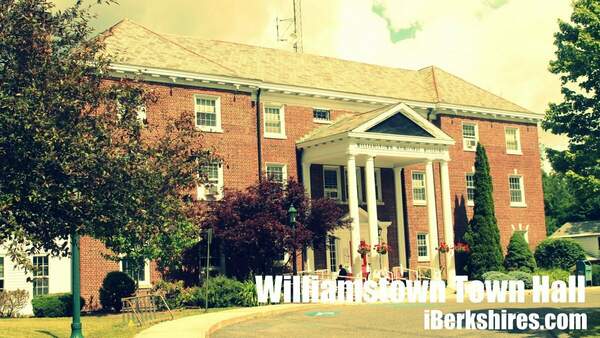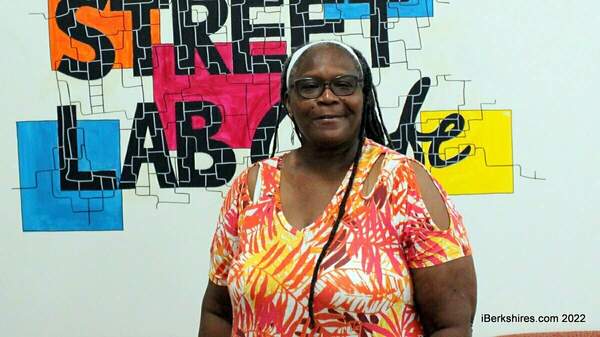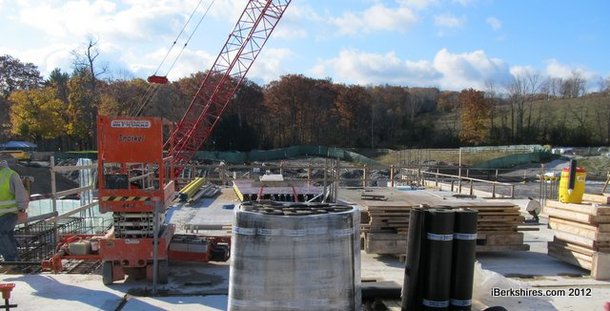
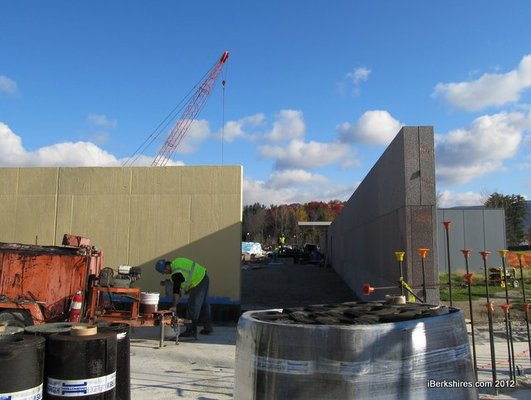
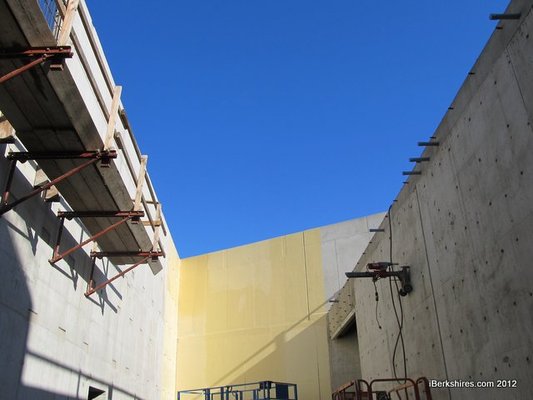
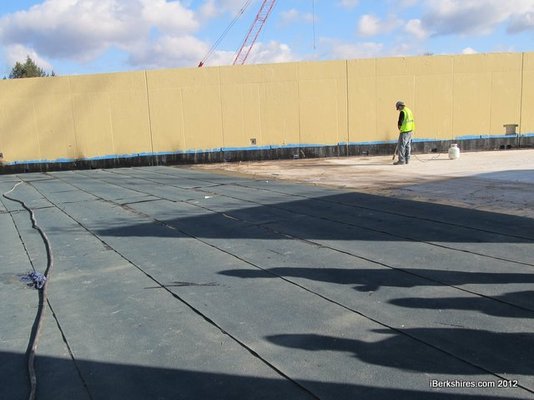
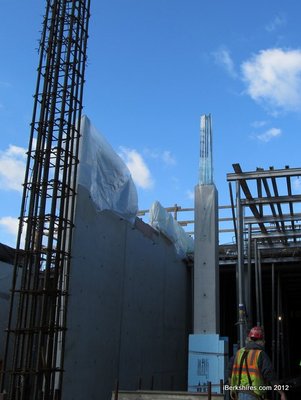
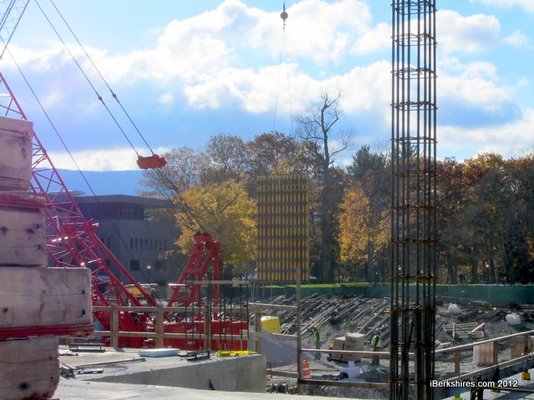
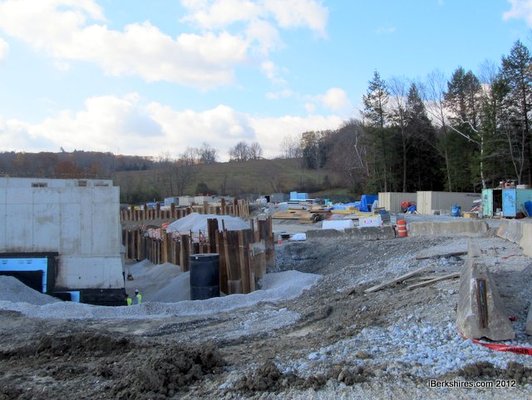
Clark Art Expansion Project Beginning to Take Shape
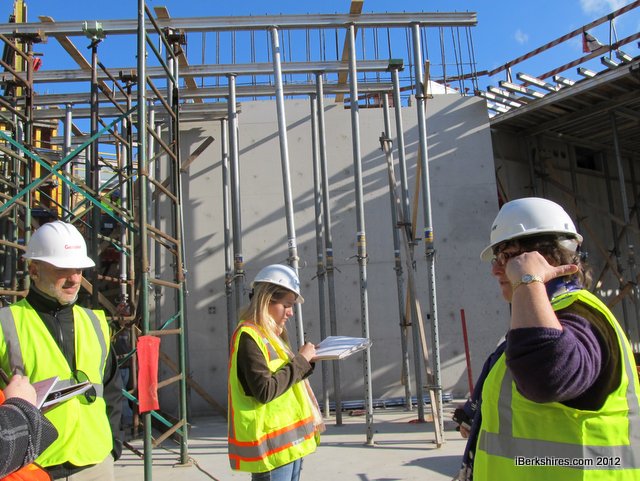 Victoria Saltzman, director of communications for the Clark Art Institute, gives a tour of the under construction entrance and exhibition space on the museum's campus. |
WILLIAMSTOWN, Mass. — The site is noisy and cluttered with construction materials, equipment, trucks and crews. It's hard to visualize architect Tadao Ando's proposed epiphany of art and nature in balance.
At least until you walk into the nascent lobby, look past the concrete forms for the reflecting pool, through the space where a wall of windows will frame the view. That's where Ando's vision lies — in the russet mountains, the grazing cows, the blue sky.
The $145 million expansion at the Clark Art Institute is at about the halfway mark in adding some 44,000 square feet including more than 10,000 square feet of gallery space, parking, walking trails, areas for rest and reflection, conferencing, cafeteria, and other features.
Director Michael Conforti believes the unique integration of art and nature will put the museum on the newest list of "1,000 place to go before you die."
"There are five or six very special places like this around the world, where these private collections can be seen in these extraordinary rural environments," he said on Monday morning. "In a new age of global tourism, I see our Clark as having a very significant role, I dare say, a leadership role."
The museum offered a tour of the construction on Monday morning for local media in conjunction with one of Ando's visits to confer on its progress. The internationally known architect and designer, of Osaka, Japan, said he could see his vision emerging from the din of construction.
"The work in progress is part of a larger plan in relationship to the Stone Hill Center [which he also designed] in relation to the landscape," said Ando through translator and fellow architect Kulapat Yantrasast. "Every time I come back, I see slowly the construction move up that linkage on the relationship being established."
For the award-winning designer, the new center will be more than a building — it will be a platform for experiencing art in ever-changing ways by breaking down barriers between interiors and exteriors.
"As you walk around from one art experience to other — in Japanese the 'ma,' the time in between — allows you to refresh your sensibilities," said Ando, who sees art as a nutrient for the soul and spirit. "The artwork is spread out to allow you to really discover from one to other; there's a chance to explore myriad things in between and create a very cohesive art experience that you can't find anywhere else."
The new addition will take advantage of the Berkshires' four seasons, encouraging visitors to keep returning for a different experience.
"I really believe the way we look at the work, the meanings and the importance of the work is really depending a lot on what state or what are your feelings at the time," said Ando. "And because of that to be able to look at the work in this wonderful natural context in the different seasons will allow you to really understand these pieces."
The design radically reorients the museum's entrance from the traditional street facing to one that pulls you into what Conforti described as "totally different campus experience" with a winding drive, lily pond, tree-lined parking lots and a long granite-faced wall blocking the street that both guides you to and prepares you for the main entrance.
The addition will also have its pragmatic functions (updated delivery access, elevators, mechanicals) as well as elements to tie it into the older buildings, such as using red granite from the same Minnesota quarry used for the 1973 building and adding a glass "box" to the original 1955 building. It's also a green building and should qualify for silver LEED certification, based largely on its ground water management system.
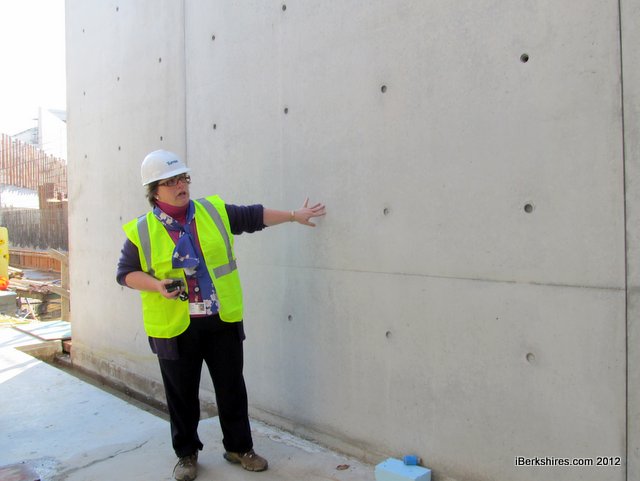 Saltzman explains the process for getting the smooth, clear architectural concrete walls. |
Victoria Saltzman, director of communications, led a hardhat tour of the site, pointing out the ways in which light will enter the new structure, the expansive special exhibitions space, and examples of the exacting expectations of Ando in design and construction such the sleek concrete architectural walls.
"It's big in terms of what we do here," said Saltzman, who added that the museum's initiatives had long outgrown the current structures. "But in terms to make it somewhat modest, and let the land and the architecture do the talking."
With the opening nearly two years away, curators are planning out how to use the new space and looking at how their colleagues are setting up the on-the-road Clark collection for inspiration.
Some 73 paintings and thousands of other works on paper and in the decorative arts have been on a three-year round-the-world trip during the renovation. It arrives in Japan for an extended stay next year; its last stop is Seoul, South Korea, before heading home in 2014. Saltzman said the museums hosting the collection have been given a free hand on display, in turn giving the Clark's curators some exciting ideas.
Saltzman said there was an incredible two-hour wait to get into the Museo Nacional del Prado in Madrid to view the collection on opening day. "It was exciting to see how ecstatic people are to see our paintings," she said.
Museum officials are hoping to brand the Clark as a global destination, attracting tourists to what Ando believes is "the best kept secret in America."
"We have a quality cultural experience but we do it in a more country conscious way," said Conforti, referring to the bucolic nature of some of the Berkshires' venues. At the Clark, it will be "art and nature and great architecture linked in all these ways and we assume more and more people will want to have that experience."
Tags: capital projects, Clark Art, construction, museum,

